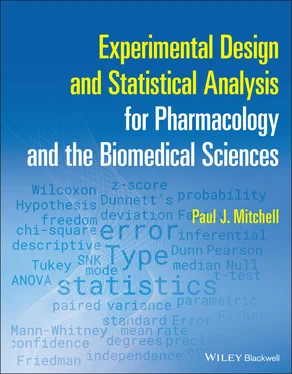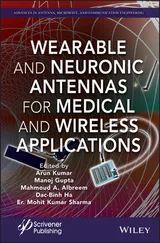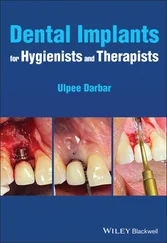Title: Experimental design and statistical analysis for pharmacology and the biomedical sciences / Paul J. Mitchell.
Description: Hoboken, NJ : John Wiley & Sons, Inc., 2022. | Includes bibliographical references and index.
Identifiers: LCCN 2021034578 (print) | LCCN 2021034579 (ebook) | ISBN 9781119437635 (paperback) | ISBN 9781119437673 (adobe pdf) | ISBN 9781119437666 (epub)
Subjects: MESH: Research Design | Pharmacology | Data Interpretation, Statistical
Classification: LCC RM301.12 (print) | LCC RM301.12 (ebook) | NLM QV 20.5 | DDC 615.1--dc23
LC record available at https://lccn.loc.gov/2021034578LC ebook record available at https://lccn.loc.gov/2021034579
Cover design: Wiley
Cover image: © RomanOkopny/Getty Images
This book is dedicated to my parents Alec and Jean, long gone but never, ever, forgotten, and to my wife, Angela, and our children Matthew and Samantha of whom I am immensely proud.

Dr Paul J Mitchell is a Senior Lecturer and an Associate Professor in the Department of Pharmacy and Pharmacology, University of Bath, United Kingdom, and Adjunct Lecturer in the Department of Pharmacology and Therapeutics, National University of Ireland (NUI), Galway, Ireland.
His career in pharmacology started in 1975 when he joined the cardiovascular group led by Dr Bob Poyser at Beecham Pharmaceuticals, Harlow, United Kingdom. After five years, during which he also graduated with an Upper Second BSc in Applied Biology (Pharmacology) from North East London Polytechnic under Prof Geof B West, he transferred to the CNS disorders group led by Dr Mike Clarke. Dr Mitchell left Beecham in 1985 to start post‐graduate studies with Dr (now emeritus Prof) Peter Redfern in the School of Pharmacy and Pharmacology, University of Bath, United Kingdom. After successfully defending his PhD thesis on the Effect of Antidepressant Treatment on Social Behaviour and Circadian Rhythms of Locomotor Activity in the Rat in 1989, he joined the research laboratories of Wyeth‐Ayerst, Taplow, principally to examine the potential antidepressant activity of novel psychotropic compounds in the rodent models of social behaviour that were developed during his postgraduate studies. The results of these behavioural studies were pivotal in the company's decision to fully develop venlafaxine (known in‐house as Wy 45030) to the clinic. Subsequently, Dr Mitchell became heavily involved in the further pre‐clinical development of venlafaxine (Effexor®, Efexor®), the world's first SNRI antidepressant drug, which was approved by the U.S.FDA in 1993 and by the MHRA in the United Kingdom in 1994.
In 1995, Dr Mitchell returned to the University of Bath to set up his own lab to continue examining the effect of antidepressant drugs on rodent social behaviour (Resident‐Intruder test and Social Hierarchy model of social behaviour), while working very closely with the pharmaceutical industry (principally colleagues at Wyeth‐Ayerst in the USA, Lundbeck in Denmark, and Organon in the United Kingdom).
Over the last 25 years, Dr Mitchell has collaborated with colleagues at the University of Bath and NUIGalway to develop a coherent strategy to teach experimental design and statistical analysis to undergraduate and postgraduate students across subject areas in the Life and Biomedical sciences.
Dr Mitchell has been a member of the British Pharmacological Society since 1985. He is currently working closely with the society on a residential training workshop on the topic of this book covering the principles of robust, rigorous, experimental design, and statistical analysis. This course is ideal for early career researchers working in drug discovery or academia.
Acknowledgements
Homo Sapiens – Part 1
Looking back over copious notes and draft versions of this book, I've come to realise that this project has taken me far longer than my initial 12‐month plan envisaged. But let me take you back to the beginning of the 2016–2017 academic year when I confronted a group of pharmacology undergraduate students who had just returned from a year's placement and were about to embark on the final year of their degree programme. My question ‘So, how're your stats skills coming along now you've been in the big wide world?’ was met with a mixture of dismay and disdain, not to say contempt for mentioning the S word! The ensuing conversation quickly dispelled any thoughts on my part regarding their progress and so I quickly put together an intense four‐week package, which covered all my statistics lectures and hands‐on data analysis workshops to get them up to speed. The feedback I received suggested that delivering such material in such a short period was successful, but one important component was missing; they had no access to a suitable concise textbook covering descriptive and inferential statistics suitable for undergraduate pharmacology students. Indeed their major complaint was that currently available textbooks were either focused on statistical theory (suitable only for highly competent students of mathematics) or were simply user guides for statistical software packages; both of which were totally inappropriate for students who simply wanted to know which statistical tests they had to use to analyse different types of experimental data. In short, they needed a concise ‘textbook’ book, which showed them how to use statistics as a tool with which they could analyse their experimental data and arrive at appropriate conclusions, thereby revealing the relationship of their data to the real world. So, it seems obvious to me that the first group of individuals that I should thank, and you, dear reader, should blame for kick‐starting this project which has resulted in the contents of this book, are the infamous seven final year pharmacology students from 2016: Charlotte Bell, Charlotte Day, Sam Groom, James Miles (yes, that cocky bugger), Katy Murrell, Gemma Wilkinson, and Alex Williams – according to my latest information most if not all have now completed (or nearly so) their subsequent PhD studies and are now forging research careers on their own (and most notably without my help!). If this book is in any way successful, then clearly you seven should be held totally accountable!
Of course, when you embark on a project that is clearly not your day job, then you need a lot of support to help you to find the time in the working day that enables you to turn that germ of an idea into fruition. My sincere thanks to all my colleagues in the Department of Pharmacy and Pharmacology at the University of Bath that in many, diverse, ways have enabled me to focus on putting this manuscript together, that have humoured me while I've ranted on regarding the statistical inadequacies in the scientific press or listened quietly while I've bombarded them with different ideas on how to describe quite complex statistical issues that an inexperienced undergraduate student may (hopefully) understand. Most importantly, my thanks to Profs Steve Ward and Roland Jones who agreed for me to move my teaching duties around that created gaps in my teaching load, which allowed me to concentrate on writing. This book is full of data examples, which, I hope, will enable the reader to understand more‐fully descriptive and inferential statistics and to envisage statistics in action. Most of the data examples are my own, and for all other examples I am very grateful to Dr Malcolm Watson. I must also thank Prof Steve Husbands and Dr Christine Edmead for their helpful comments, encouragement, and suggestions after reading the first completed draft version of the manuscript; of course, considering Steve is a medicinal/organic chemist, who (by his own admission) failed to understand anything described in the book, his comments were totally ignored!
Читать дальше













